| Monthly Tech-Tip | No tracking! No ads! | |
CELECG - Celestite Crystalline Glaze
FAAO - Fa's All-Opaque Crystalline Glaze
FAC5 - Crystal Number Five Glaze
FO - Octal Crystalline Glaze
G1214M - 20x5 Cone 6 Base Glossy Glaze
G1214W - Cone 6 Transparent Base
G1214Z1 - Cone 6 Silky CaO matte base glaze
G1215U - Low Expansion Glossy Clear Cone 6
G1216L - Transparent for Cone 6 Porcelains
G1216M - Cone 6 Ultraclear Glaze for Porcelains
G1916Q - Low Fire Highly-Expansion-Adjustable Transparent
G1947U - Cone 10 Glossy transparent glaze
G2000 - LA Matte Cone 6 Matte White
G2240 - Cone 10R Classic Spodumene Matte
G2571A - Cone 10 Silky Dolomite Matte glaze
G2826R - Floating Blue Cone 5-6 Original Glaze Recipe
G2826X - Randy's Red Cone 5
g2851H - Ravenscrag Cone 6 High Calcium Matte Blue
G2853B - Cone 04 Clear Ravenscrag School Glaze
G2896 - Ravenscrag Plum Red Cone 6
G2902B - Cone 6 Crystal Glaze
G2902D - Cone 6 Crystalline Development Project
G2916F - Cone 6 Stoneware/Whiteware transparent glaze
G2926B - Cone 6 Whiteware/Porcelain transparent glaze
G2926J - Low Expansion G2926B
G2928C - Ravenscrag Silky Matte for Cone 6
G2931H - Ulexite High Expansion Zero3 Clear Glaze
- Low Fire Fritted Zero3 Transparent Glaze
G2931L - Low Expansion Low-Fire Clear
G2934 - Matte Glaze Base for Cone 6
G2934Y - Cone 6 Magnesia Matte Low LOI Version
G3806C - Cone 6 Clear Fluid-Melt transparent glaze
G3838A - Low Expansion Transparent for P300 Porcelain
G3879 - Cone 04 Transparent Low-Expansion transparent glaze
GA10-A - Alberta Slip Base Cone 10R
GA10-B - Alberta Slip Tenmoku Cone 10R
GA10-D - Alberta Slip Black Cone 10R
GA10x-A - Alberta Slip Base for cone 10 oxidation
GA6-A - Alberta Slip Cone 6 transparent honey glaze
GA6-B - Alberta Slip Cone 6 transparent honey glaze
GA6-C - Alberta Slip Floating Blue Cone 6
GA6-D - Alberta Slip Glossy Brown Cone 6
GA6-F - Alberta Slip Cone 6 Oatmeal
GA6-G - Alberta Slip Lithium Brown Cone 6
GA6-G1 - Alberta Slip Lithium Brown Cone 6 Low Expansion
GA6-H - Alberta Slip Cone 6 Black
GBCG - Generic Base Crystalline Glaze
GC106 - GC106 Base Crystalline Glaze
GR10-A - Pure Ravenscrag Slip
GR10-B - Ravenscrag Cone 10R Gloss Base
GR10-C - Ravenscrag Cone 10R Silky Talc Matte
GR10-E - Alberta Slip:Ravenscrag Cone 10R Celadon
GR10-G - Ravenscrag Cone 10 Oxidation Variegated White
GR10-J - Ravenscrag Cone 10R Dolomite Matte
GR10-J1 - Ravenscrag Cone 10R Bamboo Matte
GR10-K1 - Ravenscrag Cone 10R Tenmoku
GR10-L - Ravenscrag Iron Crystal
GR6-A - Ravenscrag Cone 6 Clear Glossy Base
GR6-B - Ravenscrag Cone 6 Variegated Light Glossy Blue
GR6-C - Ravenscrag Cone 6 White Glossy
GR6-D - Ravenscrag Cone 6 Glossy Black
GR6-E - Ravenscrag Cone 6 Raspberry Glossy
GR6-H - Ravenscrag Cone 6 Oatmeal Matte
GR6-L - Ravenscrag Cone 6 Transparent Burgundy
GR6-M - Ravenscrag Cone 6 Floating Blue
GR6-N - Ravenscrag Alberta Brilliant Cone 6 Celadon
GRNTCG - GRANITE Crystalline Glaze
L2000 - 25 Porcelain
L3341B - Alberta Slip Iron Crystal Cone 10R
L3685U - Cone 03 White Engobe Recipe
L3724F - Cone 03 Terra Cotta Stoneware
L3924C - Zero3 Porcelain Experimental
L3954B - Cone 6 Engobe (for M340)
L3954N - Cone 10R Base White Engobe Recipe for stonewares
MGBase1 - High Calcium Semimatte 1 (Mastering Glazes)
MGBase2 - High Calcium Semimatte 2 (Mastering Glazes)
MGBase3 - General Purpose Glossy Base 1 (Mastering Glazes)
MGBase4 - Glossy Base 2 Cone 6 (Mastering Glazes)
MGBase5 - Glossy Clear Liner Cone 6 (Mastering Glazes)
MGBase6 - Zinc Semimatte Glossy Base Cone 6
MGBase7 - Raspberry Cone 6 (Mastering Glazes)
MGBase8 - Waxwing Brown Cone 6 (Mastering Glazes)
MGBase9 - Waterfall Brown Cone 6 (Mastering Glazes)
TNF2CG - Tin Foil II Crystalline Glaze
VESUCG - Vesuvius Crystalline Glaze
Insight-Live Shares (also referencing this recipe)
These add technical detail, development info, variations and improvements.
- Zero3 Porcelain, engobe, glaze, firing schedule
- Replacing the Gerstley Borate in two recipes containing 50%+
- Zero3 Clear Glazes With Firing Schedule
- Zero 3 L & K Glazes Compared to the Worthington Clear Original
- L215, glaze, engobe and firing schedule
- How to fix Gerstley Borate-based Worthington Cone 04 Clear
G2931K - Zero3 K Cone 03 Transparent Glaze
Modified: 2023-05-03 20:54:14
A cone 03-02 clear medium-expansio glaze developed from Worthington Clear.
| Material | Amount | Percent |
|---|---|---|
| Ferro Frit 3195 | 25.00 | 26.3 |
| Ferro Frit 3134 | 33.00 | 34.7 |
| EPK | 20.00 | 21.1 |
| Ferro Frit 3249 | 10.00 | 10.5 |
| Ferro Frit 3110 | 7.00 | 7.4 |
| 95.00 | 100 | |
Notes
This recipe improved on the popular Worthington Gerstley-Borate-based low fire clear recipe. It targeted cone 03 to work best on Zero3 stoneware and porcelain. To fire lower (cone 06-04), consider G1916Q (or derivatives) instead.
Unlike its Worthington Clear predecessor, this does not become a bucket of jelly, does not crack on drying, does not go on unevenly or the wrong thickness, does not cloud up with boron blue or micro-bubbles when fired (because it has lower CaO) when used on the types of bodies discussed below. It is crystal clear and super glassy at cone 03.
If you liked the variegated appearance of the GB version, titanium dioxide can be added to this to produce even better variegation. For darker color rutile with do the same.
Low fire bodies span a wide range of thermal expansions. While Worthington clear (an ancestor of this recipe) melts to a good clear, its thermal expansion was too low. This recipe, G2931K, raises thermal expansion (by adding Na2O). The thermal expansion of Zero3 stoneware and porcelain are about the middle of the range, and they develop good glaze:glaze interfaces, so this recipe fits them well.
This glaze shivers on high-talc bodies and can craze on zero-talc porous ones. This recipe has three variations we have worked with, one of higher expansion (G2931H) and one of lower expansion (G2931L). Keep in mind that adding zircon and stains changes expansion.
Dipping ware in Zero3 Transparent is just so much easier than trying to paint on commercial, slow-drying clears. For us it naturally gels to a creamy consistency at around 1.53 specific gravity (in our circumstances). However it goes on too thick at that high a value, we have found the best all-around performance at 1.43 with enough Epsom Salts to gel it back up to a creamy thixotropic consistency (a few grams per gallon).
Pay special attention to the drop-and-hold firing schedule, especially if your clay body is not fine-grained. Use 04DSDH as a model.
To mix up 5 Kg use about 4.5 kg of water to get 6.5 litres of dipping glaze. To make a brushing glaze: For each 100g of powder mix start with 125 water, 1.5 CMC gum and 1.5 Veegum and thoroughly mix in a kitchen blender (add water if it gels too much). We find the about 330g of powder produces a 500ml (about 1 pint) jar.
To make colored versions add stains as needed (if stains cause micro-bubbling or orange peel surface include 2-3% zircopax).
Related Information
G2931K Zero3 transparent glaze on Zero3 Fritware Porcelain
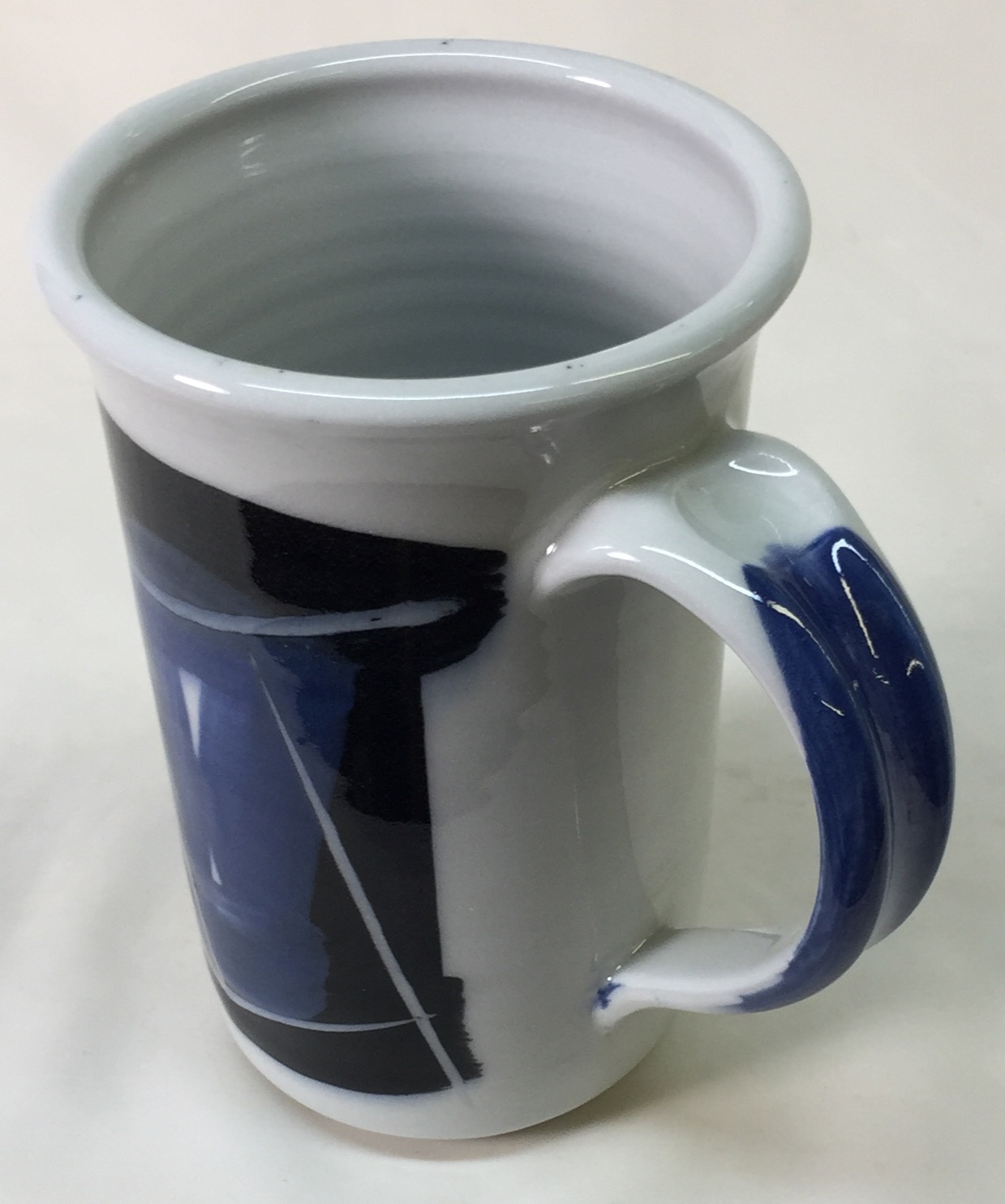
This picture has its own page with more detail, click here to see it.
This is an all-fritted version of G2931F Zero3 transparent glaze. I formulated this glaze by calculating what mix of frits must be employed to supply the same chemistry of the G2931F recipe. The mug is made from the Zero3 porcelain body (fired at cone 03) with this glaze. This glaze fits both the porcelain and the Zero3 terra cotta stoneware. The clarity, gloss, fit and durability of this glaze are outstanding.
Firing a porcelain in less than 4 hours total

This picture has its own page with more detail, click here to see it.
This porcelain mug put into kiln at 8:45am and I was drinking coffee from it at 12:15! How? One way to fast-fire is to fire a lot lower. This is Zero3 porcelain made using Dragonite Halloysite (not quite as white-burning as New Zealand Halloysite). It is the L2934C recipe. It was fired to cone 03 and glazed with G2931K clear glaze (which has fired crystal clear and flawless). I fired at 1200F/hr to 1950F, held it for 15 minutes, cooled at 999F/hr to 1850F and held it for 30 minutes, then dropped as fast as the kiln would do. Is this really porcelain? Yes. And it is super strong. The frit in the recipe is magic, making it vitrify quickly and completely.
Cone 10R porcelain (left) vs cone 03 porcelain (right)

This picture has its own page with more detail, click here to see it.
Want to make this incredible porcelain and glaze yourself? Read on. The mug on the left is a cone 10R (2350F/1290C) porcelain (#6 Tile kaolin and Nepheline Syenite) with G1947U clear glaze. The other is a fritted cone 03 (1950F or 1065C) porcelain (NZ Kaolin, Ferro Frit 3110) with G2931K clear glaze. We call the body/glaze/firing system "Zero3" (google it or use the links here). The Zero3 porcelain is blue-white instead of grey, the glaze is crystal clear, underglaze colors are so much more vibrant. This Zero3 mug was fired in 3 hours (cold-to-cold). It fits glazes really well, it is very strong and much more translucent. How is this possible? The magic of the frit, it melts so much better than nepheline. It is the most expensive body you will ever make. But from it you may create the highest quality ware you have ever made using the most plastic body you have ever thrown! Follow the instructions carefully.
One way for an ultra clear at low fire: Magnesia-alkali, low Si:Al ratio, more boron.

This picture has its own page with more detail, click here to see it.
On the left is G2931J, a zinc alkali fluxed and high Si:Al ratio glaze. Those look like micro-bubbles but they are much more likely to be micro-crystals (high-zinc and high-silica is the mechanism for crystalline glazes). G2931K on the right has much more boron, double the Al2O3, less SiO2 and is magnesia-alkali instead of zinc-alkali. It is the product of dozens of tests to find an ultra-clear having a glassy smooth surface. This particular chemistry, although having only a 6:1 SiO2:Al2O3 ratio is ultra-gloss. In addition, is has low expansion, will fast fire and the boron is not high enough to compromise the hardness.
What happens if Zero3 Clear is applied too thick

This picture has its own page with more detail, click here to see it.
It runs downward during firing and the thicker sections have micro-bubbles that clouds the otherwise crystal-clear glass.
G2931K Transparent cone 03 with 15% inclusion stains

This picture has its own page with more detail, click here to see it.
On Zero3 porcelain. Between 10 and 15% stain with 2-3% Zirocpax (zircon) added (to prevent bubbling). The firing schedule approached cone 03 (1950F) at 100F/hr for the final 100 degrees, held for 5 minutes, dropped to 1800 and held for 30 minutes.
The varying power of different encapsulated stains
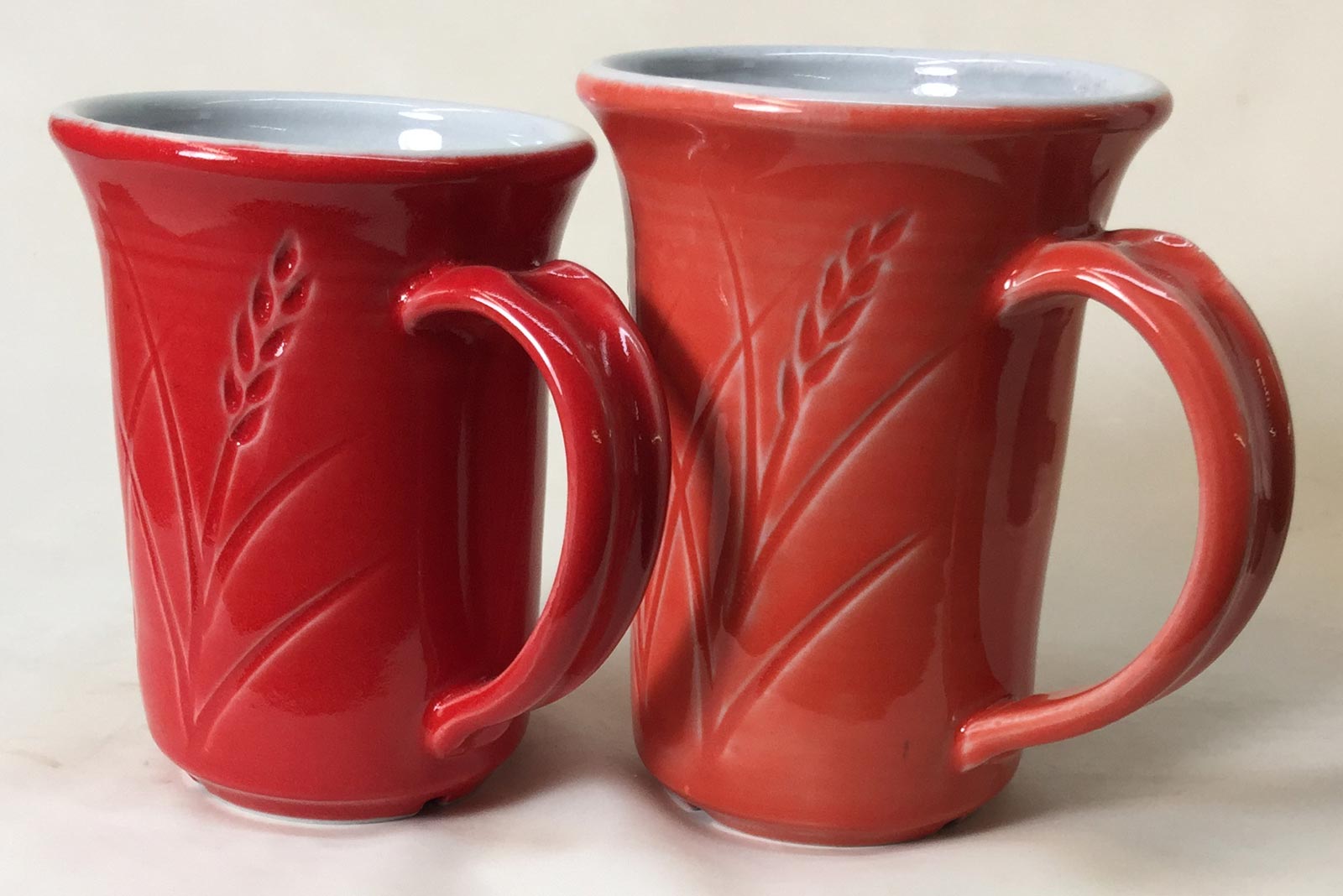
This picture has its own page with more detail, click here to see it.
These mugs are fired at cone 03. The outside glazes are G2931K transparent with added stain plus 3% Zircopax. The left one contains 10% Mason 6021 red. The right one has 15% Cerdec 297497 red stain. The latter is an older product, obviously not as potent. Encapsulated stains are a revolution in ceramics but test the ones available. You could save money and get better color at the same time.
Dip-glazing vs. brush-on glazing: Which gives the more even surface?
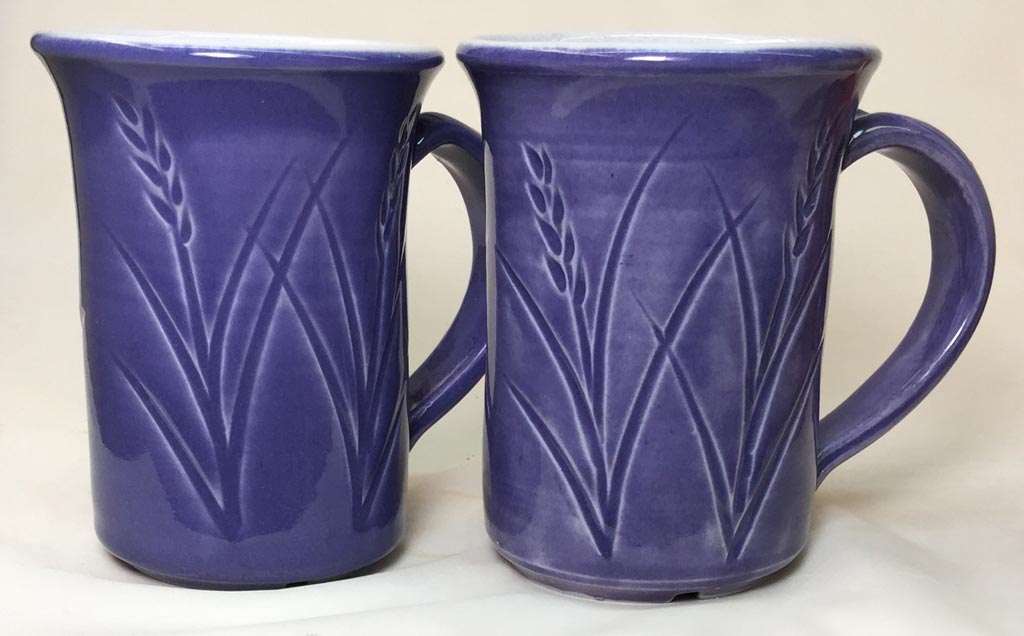
This picture has its own page with more detail, click here to see it.
This is a clear glaze (G2931K) with 10% purple stain (Mason 6385). The mugs are cone 03 porcelain (Zero3). The mug on the left was dipped (at the bisque stage) into a slurry of the glaze (having an appropriate specific gravity and thixotropy). The glaze dried in seconds. The one on the right was painted on (two layers). Like any paint-on glaze, it contains gum (1% CMC). Each layer required several minutes of application time and fifteen minutes of drying time. Yet it is still not evenly applied.
Three low fire bodies need three different clear glazes. Why?
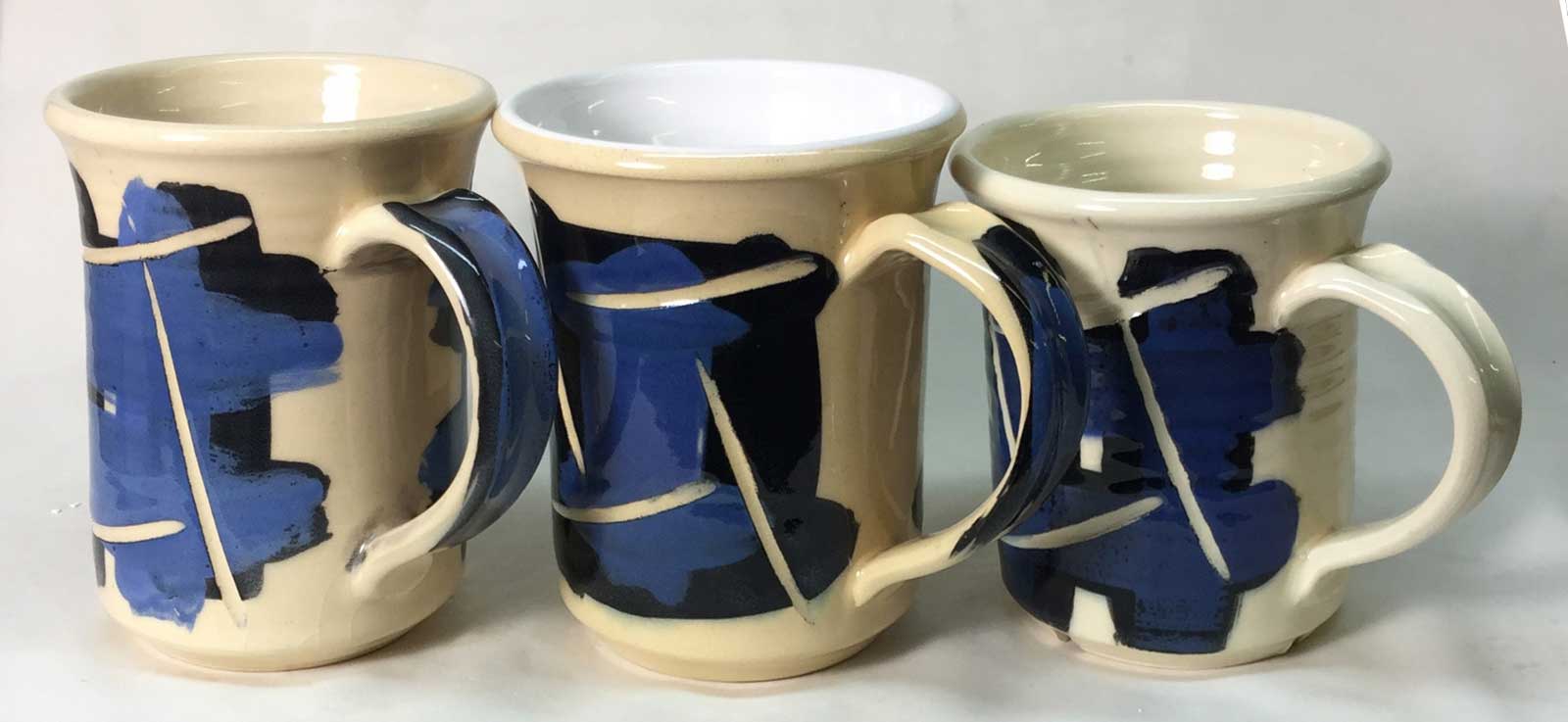
This picture has its own page with more detail, click here to see it.
Glaze fit. The left-most clay mug contains no talc (Plainsman Buffstone), the centre one about 25% talc (L212) and the right one is about 45% talc (L213). Talc raises thermal expansion. The centre glaze is G2931K, it is middle-of-the-road thermal expansion (Insight-live reports it as 7.4) and fits the low-talc bodies (and Zero3 porcelain and stoneware). But it crazes on Buffstone and shivers on L213. The lesson is: Forget about expecting one clear or base glaze to fit all low fire bodies. But there is a solution. I adjusted it to reduce its expansion to work on zero-talc porous bodies and raise it to work on high talc bodies. How? By decreasing and increasing the KNaO (in relation to other fluxes). The three fire crystal clear and work the best in a drop-and-hold firing.
Underglazes, engobe, a good transparent glaze and cone 03. Life is good!

This picture has its own page with more detail, click here to see it.
The white engobe was applied by pouring at leather hard stage. The underglazes were also painted on at leather hard. The mugs were then dried, cleaned, bisque fired, dipping in clear glaze and final fired to cone 03. The clay and engobe have frit additions to make them vitrify at low temperatures.
Low fire heaven: Use commercial underglazes but make your own clear over glaze
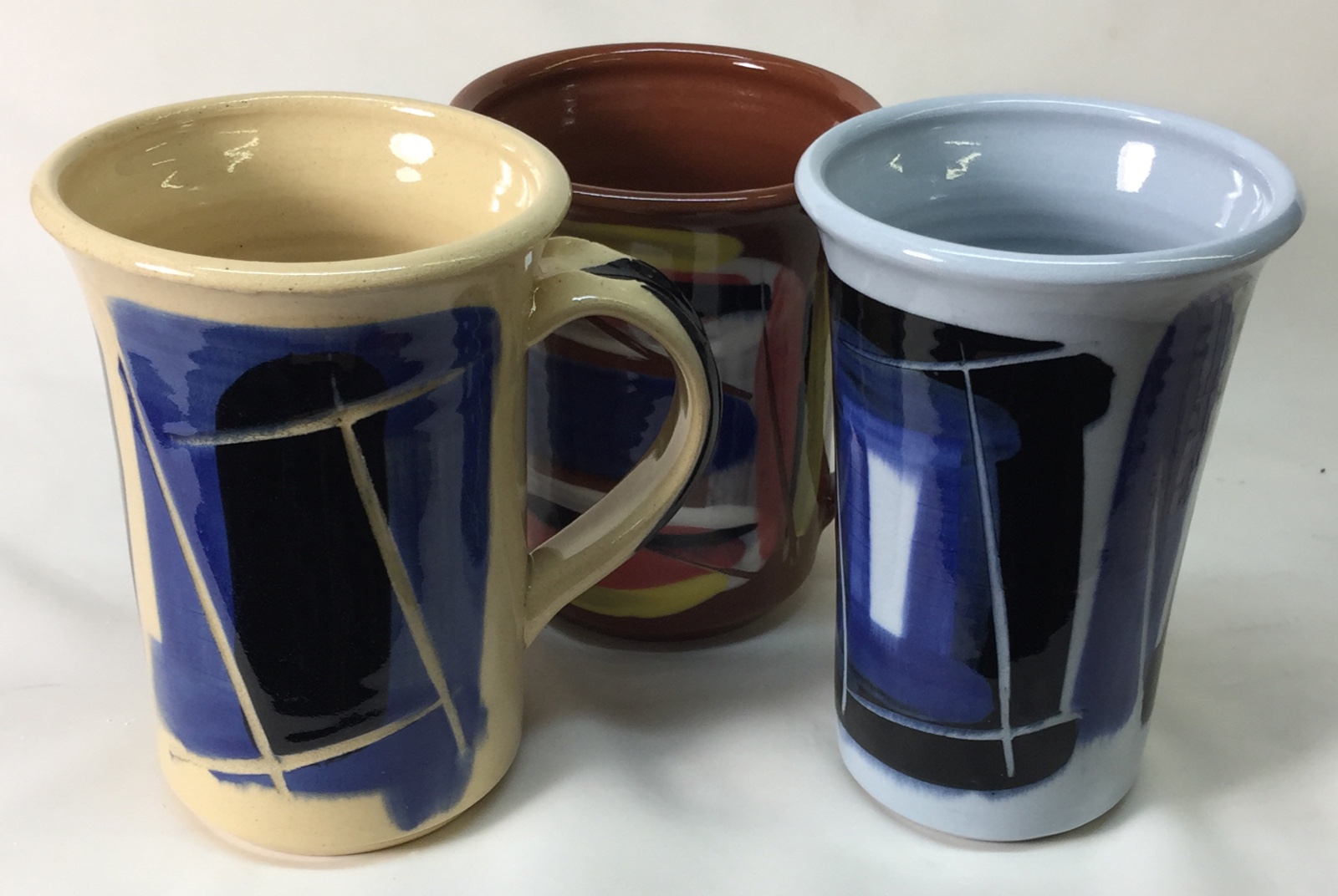
This picture has its own page with more detail, click here to see it.
Decorate ware with the underglazes at the leather hard stage, dry and bisque fire it and then dip-glaze in a transparent that you make yourself (and thus control). These mugs are fired at cone 03. All have the same transparent glaze (G2931K), all were decorated with the same underglazes. Notice how bright the colors are compared to middle or high temperature. On the left is a porous talc/stoneware blend (Plainsman L212), rear is a fritted Zero3 stoneware and right is Zero3 fritted porcelain. When mixed properly you can dip ware in this glaze and it covers evenly, does not drip and dries enough to handle in seconds! Follow the Zero3 firing schedule and you will have ware of amazing quality.
Why would a low fire transparent require four frits?

This picture has its own page with more detail, click here to see it.
To get the needed chemistry to avoid boron blue clouding (calcium borate crystals). The one on the right clouds, the other does not. Why? Differences in the chemistry (as seen in my account at insight-live.com). G2931K, on the left, has greater Al2O3 (which impedes the growth of crystals), lower CaO (starves their growth) and more boron (for better melting). There is actually no practical way to adjust the recipe on the right (by supplying MgO with talc and fiddling with frit percentages) to achieve this. Frit 3124 lacks Na2O and B2O3. 3134 has excessive CaO and almost zero Al2O3. Talc does not melt well enough. But Frit 3249 supplies the needed MgO and has lots of B2O3 and low CaO. And Frit 3110 has low CaO and supplies the needed Na2O.
When it makes sense to fire hotter than cone 04

This picture has its own page with more detail, click here to see it.
The body is Plainsman L215 (bisque fired at cone 06). These commercial underglazes are not temperature-specific, they work the same across a wide range of temperatures. But the glaze is G2931K, it was designed for cone 03 and does not melt as well at cone 04 (for example, it goes milky if applied too thick), it was for use on Zero3 stoneware and Zero3 porcelain. This body is, however, a standard porous earthenware. While it is normally fired at cone 06-04, it tolerates cone 03. Actually, it benefits from cone 03, firing stronger and a deeper red color. So, since this glaze and body are both better at cone 03, it makes total sense to fire pieces like that at that temperature.
Terra cotta transparent glaze: Too thick and just right

This picture has its own page with more detail, click here to see it.
When clear-glazing terra cotta ware (Plainsman L215 here) an important issue is glaze thickness. The mug on the left was double-dipped (so suspended bubbles are present in the handle recess, thumb-hold and along its edges). The glaze needs to be thick enough so that it feels glassy smooth but thin enough to avoid the bubbles. Normally, if applied the thickness of the one on the left, it would be completely milky, filled with micro-bubble clouds. Why has it not done so here? Because it is fired at cone 03 (using G2931K glaze and the C03DRH firing schedule). An added benefit is that the body is so much stronger than it would be if fired at cone 06 or 04. And the underglazes work fine.
Links
| Recipes |
G2931H - Ulexite High Expansion Zero3 Clear Glaze
A cone 03-02 higher expansion fritted clear glaze developed from Worthington Clear. |
| Recipes |
L3924C - Zero3 Porcelain Experimental
|
| Recipes |
G2931L - Low Expansion Low-Fire Clear
A cone 03-02 low expansion clear ceramic glaze developed from Worthington Clear. |
| Recipes |
G1916Q - Low Fire Highly-Expansion-Adjustable Transparent
An expansion-adjustable cone 04 transparent glaze made using three common Ferro frits (low and high expansion), it produces an easy-to-use slurry. |
| Glossary |
Transparent Glazes
Every glossy ceramic glaze is actually a base transparent with added opacifiers and colorants. So understand how to make a good transparent, then build other glazes on it. |
| Glossary |
Zero3
The designation for a group recipes for body, glaze and engobe (by Tony Hansen), that potters can use to make low fire stoneware and fritware porcelain at 1100C (2000F) or cone 03. |
| Articles |
Where do I start in understanding glazes?
Break your addiction to online recipes that don't work or bottled expensive glazes that you could DIY. Learn why glazes fire as they do. Why each material is used. How to create perfect dipping and brushing properties. Even some chemistry. |
| Articles |
Concentrate on One Good Glaze
It is better to understand and have control of one good base glaze than be at the mercy of dozens of imported recipes that do not work. There is a lot more to being a good glaze than fired appearance. |
| Articles |
The Majolica Earthenware Process
How to make strong, durable functional ware from red terra cotta odies based on the traditional of majolica. |
| URLs |
https://insight-live.com/insight/share.php?z=8JFvDgDc3X
Plainsman Zero3 Glaze L,K,H and Firing Schedule |
| URLs |
https://insight-live.com/insight/share.php?z=5R9GFgEEYF
Zero3 porcelain/stoneware, engobe, clear glaze and firing schedule |
XML to Paste Into Insight-live
<?xml version="1.0"?> <recipes version="1.0" encoding="UTF-8"> <recipe name="Zero3 K Cone 03 Transparent Glaze" keywords="A cone 03-02 clear medium-expansio glaze developed from Worthington Clear." id="132" date="2023-05-03" codenum="G2931K"> <recipelines> <recipeline material="Ferro Frit 3195" amount="25.000"/> <recipeline material="Ferro Frit 3134" amount="33.000"/> <recipeline material="EPK" amount="20.000"/> <recipeline material="Ferro Frit 3249" amount="10.000"/> <recipeline material="Ferro Frit 3110" amount="7.000"/> <url url="https://digitalfire.com/recipe/132" descrip="https://digitalfire.com/recipe/132"/> </recipelines> <urls/> </recipe> </recipes>
| By Tony Hansen Follow me on        |  |
Got a Question?
Buy me a coffee and we can talk

https://digitalfire.com, All Rights Reserved
Privacy Policy
